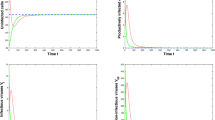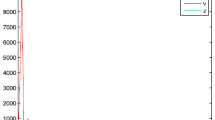Abstract
In this paper, we consider a four dimensional model of the human immunodeficiency virus-1 (HIV-1) with delay, which is an extension of some three dimensional models. We approach the treatment problem by adding two controllers to the system for inhibiting viral production. The optimal controller \(u_{1}\) is considered for vaccine and \(u_{2}\) for the drug. The Pontryagin maximum principle with delay is used to characterize these optimal controls. At the end, numerical results are presented to illustrate the optimal solutions. The validity of the model was confirmed by proper semi-quantitative simulation of some clinical data. The model was used to predict the possible beneficial effects of vaccine and anti-retroviral drug administration in HIV-1 disease.










Similar content being viewed by others
References
Aniţa S, Arnăutu V, Capasso V (2011) An introduction to optimal control problems in life sciences and economics: from mathematical models to numerical simulation with MATLAB. Birkhäuser, Boston
Balasubramaniam P, Tamilalagan P, Prakash M (2015) Bifurcation analysis of HIV infection model with antibody and cytotoxic T-lymphocyte immune responses and beddington-deangelis functional response. Math Methods Appl Sci 38(7):1330–1341
Collins C, Fister K, Williams M (2010) Optimal control of a cancer cell model with delay. Math Model Nat Phenom 5(3):63–75
Elaiw A (2010) Global properties of a class of HIV models. Nonlinear Anal Real World Appl 11(4):2253–2263
de Goede AL, Vulto AG, Osterhaus ADME, Gruters RA (2015) Understanding HIV infection for the design of a therapeutic vaccine. Part II: vaccination strategies for HIV. In: Annales Pharmaceutiques Françaises, vol 73, no. 3. Elsevier, pp 169–179
Göllmann L, Kern D, Maurer H (2009) Optimal control problems with delays in state and control variables subject to mixed control-state constraints. Optim Control Appl Methods 30(4):341–365
Grigorieva EV, Khailov EN, Bondarenko NV, Korobeinikov A (2014) Modeling and optimal control for antiretroviral therapy. J Biol Syst 22(02):199–217
Hale JK, Lunel SMV (2013) Introduction to functional differential equations, vol 99. Springer, New York
Hattaf K, Yousfi N (2012) Optimal control of a delayed HIV infection model with immune response using an efficient numerical method. In: ISRN biomathematics
Herasimtschuk A, Downey J, Nelson M, Moyle G, Mandalia S, Sikut R, Adojaan M, Stanescu I, Gotch F, Imami N (2014) Therapeutic immunisation plus cytokine and hormone therapy improves CD4 T-cell counts, restores anti-HIV-1 responses and reduces immune activation in treated chronic HIV-1 infection. Vaccine 32(51):7005–7013
Hey-Cunningham WJ, Murray JM, Natarajan V, Amin J, Moore CL, Emery S, Cooper DA, Zaunders J, Kelleher AD, Koelsch KK et al (2015) Early antiretroviral therapy with raltegravir generates sustained reductions in HIV reservoirs but not lower T-cell activation levels. AIDS 29(8):911–919
Hogan CM, DeGruttola V, Sun X, Fiscus SA, Del Rio C, Hare CB, Markowitz M, Connick E, Macatangay B, Tashima KT et al (2012) The setpoint study (ACTG A5217): effect of immediate versus deferred antiretroviral therapy on virologic set point in recently HIV-1-infected individuals. J Infect Dis 205(1):87–96
Joshi HR (2002) Optimal control of an HIV immunology model. Optim Control Appl Methods 23(4):199–213
Karrakchou J, Rachik M, Gourari S (2006) Optimal control and infectiology: application to an HIV/AIDS model. Appl Math Comput 177(2):807–818
Kwon HD (2007) Optimal treatment strategies derived from a HIV model with drug-resistant mutants. Appl Math Comput 188(2):1193–1204
Laarabi H, Abta A, Hattaf K (2015) Optimal control of a delayed SIRS epidemic model with vaccination and treatment. Acta Biotheoretica 63(2):87–97
Laubenbacher R (2007) An introduction to optimal control applied to immunology problems. In: Modeling and simulation of biological networks, vol 64. American Mathematical Soc, pp 94–110
Launay O, Surenaud M, Desaint C, Hamouda NB, Pialoux G, Bonnet B, Poizot-Martin I, Gonzales G, Cuzin L, Bourgault-Villada I et al (2013) Long-term CD4+ and CD8+ T-cell responses induced in HIV-uninfected volunteers following intradermal or intramuscular administration of an HIV-lipopeptide vaccine (anrs vac16). Vaccine 31(40):4406–4415
Le T, Wright EJ, Smith DM, He W, Catano G, Okulicz JF, Young JA, Clark RA, Richman DD, Little SJ et al (2013) Enhanced CD4+ T-cell recovery with earlier HIV-1 antiretroviral therapy. N Engl J Med 368(3):218–230
Lenhart S, Workman JT (2007) Optimal control applied to biological models. CRC Press, Boca Raton
Macatangay BJ, Rinaldo CR (2015) Preserving hiv-specific t cell responses: does timing of antiretroviral therapy help? Curr Opin HIV AIDS 10(1):55–60
Margolis DM (2014) How might we cure HIV? Curr Infect Dis Rep 16(3):1–5
Palmisano L, Vella S (2011) A brief history of antiretroviral therapy of HIV infection: success and challenges. Annali dell’Istituto superiore di sanita 47(1):44–48
Roy PK (2016) Mathematical models for therapeutic approaches to control HIV disease transmission. Springer, New York
Sáez-Cirión A, Bacchus C, Hocqueloux L, Avettand-Fenoel V, Girault I, Lecuroux C, Potard V, Versmisse P, Melard A, Prazuck T et al (2013) Post-treatment HIV-1 controllers with a long-term virological remission after the interruption of early initiated antiretroviral therapy ANRS VISCONTI study. PLoS Pathog 9(3):E1003211
Shamsara E, Afsharnezhad Z, Efatti S (2016a) Optimal drug control of a four dimensional HIV infection model. Preprint
Shamsara E, Afsharnezhad Z, Mostolizadeh R (2016b) Hopf bifurcation for a discontinuous HTLV-1 model. Filomat. http://journal.pmf.ni.ac.rs/filomat/index.php/filomat/article/view/3401
Shamsara E, Javidmanesh E, Afsharnezhad Z (2016c) Stability and hopf bifurcation of a discontinuous HTLV-1 model with delayed CTL immune response. Preprint
Shim H, Han SJ, Chung CC, Nam SW, Seo JH (2003) Optimal scheduling of drug treatment for HIV infection: continuous dose control and receding horizon control. Int J Control Autom Syst 1:282–288
Shu H, Wang L, Watmough J (2013) Global stability of a nonlinear viral infection model with infinitely distributed intracellular delay and CTL immune responses. SIAM J Appl Math 73(3):1280–1302
Stöhr W, Fidler S, McClure M, Weber J, Cooper D, Ramjee G, Kaleebu P, Tambussi G, Schechter M, Babiker A et al (2013) Duration of HIV-1 viral suppression on cessation of antiretroviral therapy in primary infection correlates with time on therapy. PloS one 8(10):e78287
Tian X, Xu R (2014) Global stability and hopf bifurcation of an HIV-1 infection model with saturation incidence and delayed CTL immune response. Appl Math Comput 237:146–154
Volberding PA, Deeks SG (2010) Antiretroviral therapy and management of HIV infection. The Lancet 376(9734):49–62
Wang J, Wang K, Jiang Z (2015) Dynamical behaviors of an HTLV-I infection model with intracellular delay and immune activation delay. Adv Differ Equ 1:1–17
Wodarz D (2014) Modeling T cell responses to antigenic challenge. J Pharmacokin Pharmacodyn 41(5):415–429
Yu W, Cao J (2007) Stability and hopf bifurcation on a two-neuron system with time delay in the frequency domain. Int J Bifurcat Chaos 17(4):1355–1366
Author information
Authors and Affiliations
Corresponding author
Rights and permissions
About this article
Cite this article
Shamsara, E., Shamsara, J. & Afsharnezhad, Z. Optimal control therapy and vaccination for special HIV-1 model with delay. Theory Biosci. 135, 217–230 (2016). https://doi.org/10.1007/s12064-016-0234-x
Received:
Accepted:
Published:
Issue Date:
DOI: https://doi.org/10.1007/s12064-016-0234-x




